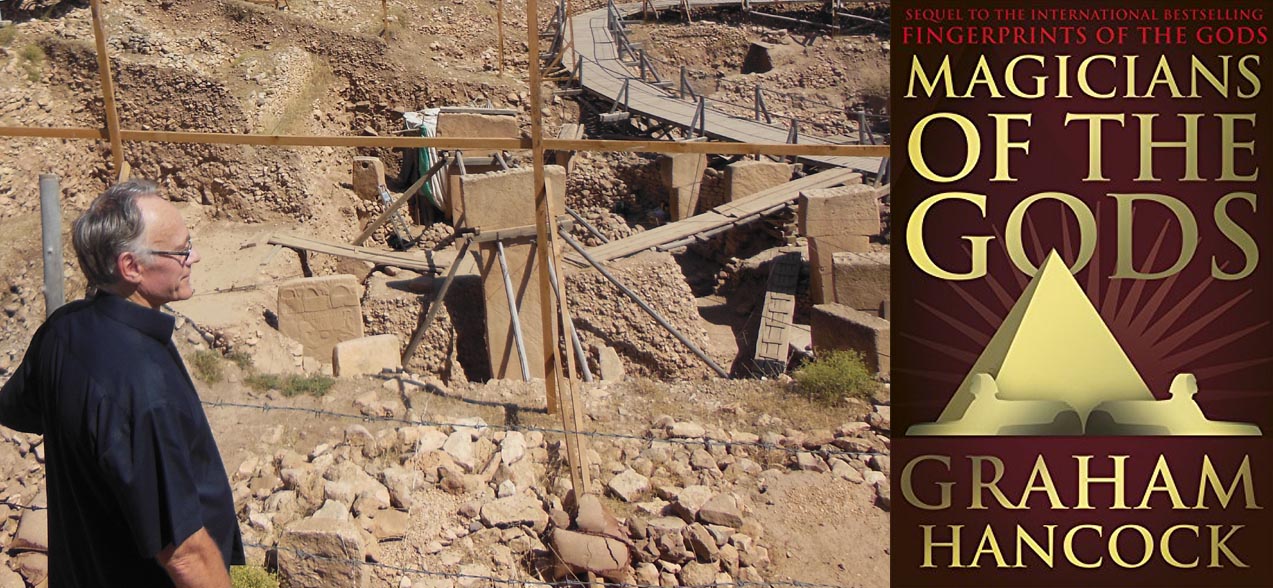
Graham Hancock at Göbekli Tepe in 2013 (pic credit: Andrew Collins), and the cover of the UK edition of Magicians of the Gods.
ITS
PROPOSED ASTRONOMICAL CONSIDERATIONS
AT GÖBEKLI TEPE - A CRITIQUE
By Andrew Collins

Graham
Hancock at Göbekli Tepe in 2013 (pic credit: Andrew Collins), and the cover
of the UK edition of Magicians of the Gods.
Graham Hancock's new book Magicians of the Gods is a well-constructed, innovative work, which I have reviewed elsewhere. It reignites interest in the ancient mysteries subject for a new generation, and will be a great success worldwide. There are, however, certain issues relating to Hancock's vision of Göbekli Tepe, the 11,500-year-old temple complex in southeast Turkey, that need addressing. This includes his opinions on the site's proposed astronomical alignments, along with his interpretation of the carved imagery on Enclosure D's Pillar 43, otherwise known as the Vulture Stone, both of which have profound implications with respect to the site's original function and purpose.
A
Matter of Orientation
The first query relates to the orientation of Göbekli Tepe's four main enclosures, designated the letters A, B, C & D in the order of their discovery (see fig. 1). Within a section on the site's suspected astronomical alignments Hancock dismisses the idea that these enclosures are oriented north towards the circumpolar and near circumpolar stars as. In his opinion the structures occupy an area within a gradually rising slope that would have obscured any sight of the northern horizon. This interpretation of the site allows him to conclude that these structures must therefore be oriented south towards the stars of the southern sky, such as Orion, as proposed by Boston geologist Robert Schoch,(1) and Sirius, as proposed by Italian archaeoastronomer Giulio Magli.(2)
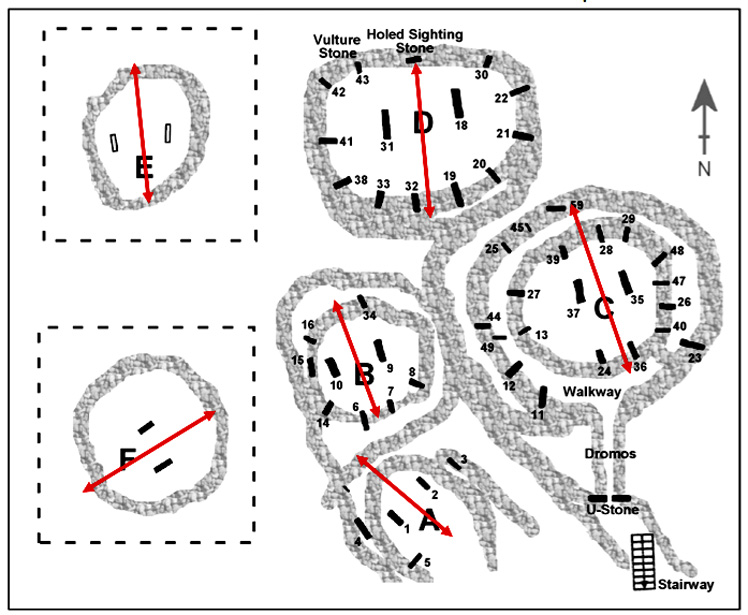
Figure
1. The layout of Göbekli Tepe's main enclosures C, B, C, D, E and F (pic
credit: Rodney Hale).
As demonstrated elsewhere, claims that the twin central monoliths of enclosures B, C and D in particular target the rising of the belt stars of Orion or the star Sirius are seriously flawed,(3) and are not correct for the epoch of their construction. What is more, the four main enclosures uncovered at Göbekli Tepe were built on fairly level bedrock situated on a hill ridge. Only afterwards were they deliberately buried beneath an artificial mound or tepe of imported earth, rubble, stone chippings, and human refuse that reaches around 15 metres in height and covers an area of approximately 300 x 200 metres. This means that before the mound was created there would, most likely, have been a clear view of the local horizon in every direction and not just towards the south.
The theory that the main enclosures at Göbekli Tepe face south is itself based on a false impression presented by the layout of the archaeological site today. The structures exposed exist in an excavated area cut into the southeastern slope of the artificial hill, suggesting a southerly orientation (see fig. 2). Yet according to a georadar survey conducted at the site in 2004, as many as 20 more large structures (Hancock suggests as many as 50) await exploration beneath the mound. Many of these will have been built directly on to the bedrock at other locations beneath the tepe, and not simply at its southernmost point.
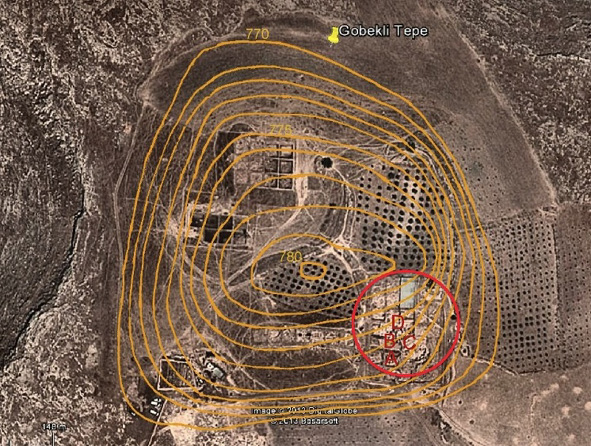
Figure.
2. Göbekli Tepe with contours overlaid, and the site of Enclosures A, B,
C & D ringed (Pic credit: Google Earth/DigitalGlobe/Rodney Hale).
Adding to the popular belief that the main enclosures at Göbekli Tepe are oriented south is the fact that the relief carving on their twin central pillars faces south. Since this includes their anthropomorphic features, such as the crooked arms seen on their wide faces and the hands seen to reach around their front narrow edges, it is assumed that the T-pillars, in their role as abstract figurative statues, gaze out towards the stars that rise on the southern horizon. However, the entrances to these enclosures are themselves located in the south, showing clearly that the entrant approaches the twin T-pillars from this direction. This manner of approach can be likened to the way a Christian enters a church and beholds statues of divinities as they advance towards the easterly-placed high altar.
In Christian tradition the high altar is located in the east because this is the chosen direction of heaven, and thus the place of resurrection on the Day of Judgement. Any statues of Jesus, the Virgin Mary, etc., do not gaze over the shoulders of the beholder towards something unseen in the west; they are there in order that the entrant might fix his or her gaze on them as they enter the building. In doing so, the entrant connects with the idols and their meaning. This allows the person entering the church to adopt a state of reverence in preparation for spiritual activity.
Göbekli Tepe's main enclosures, built with southerly entrances facing the twin central pillars, can be viewed in a similar way. They are designed in order that the entrant, after entering from the south, beholds the twin monoliths and gazes between them northwards into the enclosures' liminal area. In the case of Enclosures C and D, the initiate's gaze would have been towards a holed standing stone located in the section of wall immediately before them. Only the example in Enclosure D is still in situ (see fig. 3). The one in Enclosure C (Pillar 59) has been fractured across its aperture and is now on its right side with its front face towards the ground. Moreover, an inner circle of smaller stones was constructed inside the larger ring at some later date, obscuring the view from the central pillars towards the holed stone.
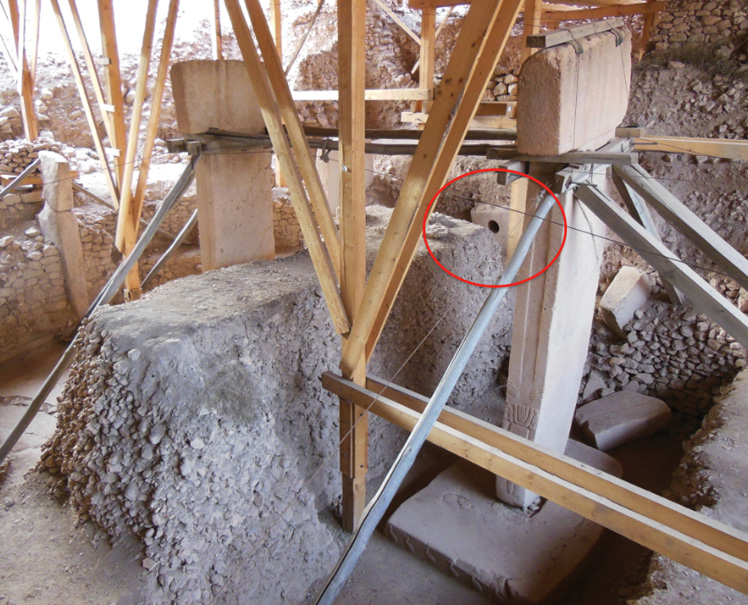
Figure
3. Göbekli Tepe's Enclosure D with its holed stone marked (Pic credit: Andrew
Collins)
Like the spirit holes used in Siberian shamanism, the circular apertures in the standing stones, which are around 30 centimetres in diameter (see figs. 4 & 5), would have served as points of connection between the physical environment and the unseen realms accessed by the soul or spirit of the practitioner during soul journeys and other similar rites.
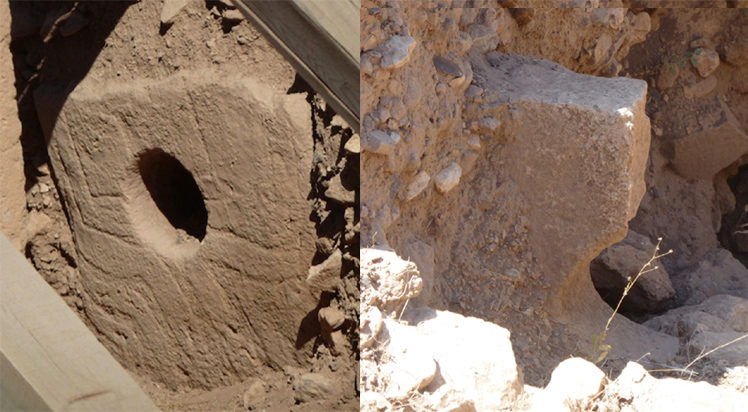
Figure
4 & 5. Enclosure D and C's holed stones (pic credit: Andrew Collins).
In
this manner, the holed stones probably functioned as the structures' "holy
of holies," and were perhaps even the earliest form of stone altars. The
recent discovery at Sanliurfa Museum of a tiny bone plaque found at Göbekli
Tepe showing twin T-pillars between which is a possible soul hole, like the ones
represented by the holed stones in its main enclosures,(4) is further confirmation
of the northerly orientation of these structures. Indeed, a fresh examination
of the plaque's etching by British engineer Rodney Hale shows that lines signifying
walls and pathways leading between the T-pillars, when extended, converge at the
prominent peck mark possibly representing the holed stone. Once again this emphasises
the northerly orientation of the enclosures (see fig. 6 & 7).
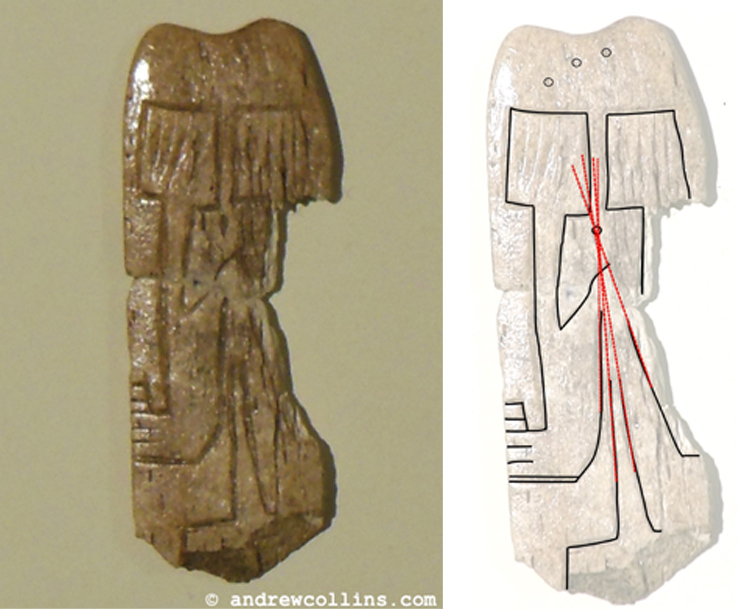
Figures
6 & 7. Left, the bone plaque found at Göbekli Tepe and now on display
in Sanliurfa Museum (pic credit: Andrew Collins). Right, the plaque's main etchings
showing lines converging on the deeply pecked hole (pic credit: Hugh Newman/Rodney
Hale).
The Enigma of Pillar 43 - the Vulture Stone
One other point to address is Hancock's interpretation of the carved imagery on Göbekli Tepe's Pillar 43, otherwise known as the Vulture Stone (see fig. 8). This is located in the NNW section of Enclosure D's perimeter wall, which once contained 12 T-shaped pillars, as well as the above mentioned holed stone, which stands immediately to the east of the Vulture Stone.
The principal symbol shown on the pillar is a large vulture, its wings slightly retracted in the likeness of a letter "W." Below it is the carved relief of a scorpion. Archaeoastronomers such as Juan Belmonte have concluded that the scorpion is a representation of Scorpius, the celestial scorpion.(5) If correct, this implies that the vulture might likewise possess a celestial counterpart. In Magicians of the Gods Hancock adopts the theory proposed by Paul Burley.(6) He interprets the vulture as representing the constellation of Sagittarius, which sits astride the Milky Way's Dark Rift next to Scorpius. Hancock adds that the relief of a filled circle, or ball-like object, just above the bird's left wing is the sun in Sagittarius at the time of the winter solstice, a synchronization that only occurs in our present precessional cycle during the epoch 1960-2040. This allows Hancock to propose that the carved imagery of the Vulture Stone is a clear message being conveyed across time by the Göbekli builders, warning us that during this 80-year window the comet responsible for a terrifying impact event at the commencement of the Younger Dryas around ca. 10,800 BC, or at least some of its remaining fragments, might once again threaten the world.

Figure
8. Pillar 43 in Göbekli Tepe's Enclosure D showing its position in the structure's
perimeter wall.
This is a daring and somewhat disturbing claim that once made, is unlikely to be undone. Yet is it right? Is it even appropriate to interpret the carved imagery of the Vulture Stone in this way?
The scorpion on Pillar 43 is, quite rightly, to be seen as arguably the earliest known pictorial representation of the Scorpius constellation, something I argue in Göbekli Tepe: Genesis of the Gods (2014). Yet on the Euphrates from earliest times the vulture has been identified with just three constellations: Cygnus, the celestial bird of Hellenic tradition; Lyra, the celestial lyre of Orpheus, known also as the Falling Vulture; and Aquila, the celestial eagle called also the Flying Vulture. All three constellations are found in the same area of sky, their brightest stars - Deneb, Vega and Altair respectively - being known collectively as the Summer Triangle.
The avian form of these three asterisms was interpreted in Hellenistic mythology as the three Stymphalian birds that attack Hercules during his Sixth Labour. These aerial creatures are usually described as monstrous raptors (birds of prey), confirming the vulture-like nature of all three asterisms (the Hercules constellation is located very close to these three celestial birds - see fig. 9). Nowhere on the Euphrates is Sagittarius identified as a heavenly vulture; even though the Stymphalian birds as Cygnus, Lyra and Aquila are all paranatellons of Sagittarius; that is they rise alongside a zodiacal constellation, in this instance Sagittarius.(7)
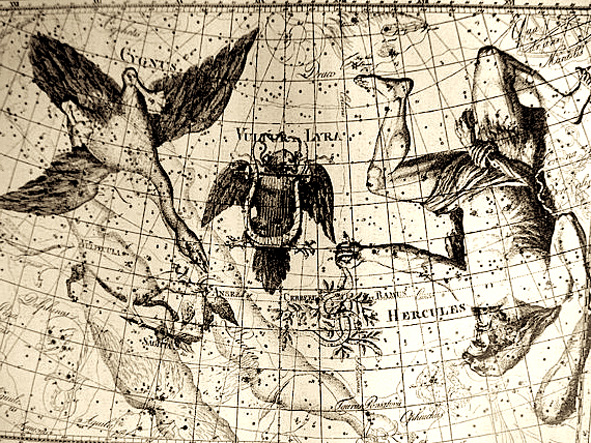
Figure
9. Star chart showing Cygnus as a swan, Lyra as both a vulture and lyre, and Hercules
upside down to the right. Aquila lies just beyond the illustration's bottom left-hand
corner.
If the vulture on Pillar 43 does indeed represent one of these three celestial birds (and, interestingly, there are in all six birds of various species and sizes found among its carved relief), then it has to be Cygnus. Not only do the twin central pillars in Enclosure D (and also those in Enclosures B, C & E) accurately target the setting of Deneb, Cygnus's brightest star, in the epoch of its construction (these alignments were recently confirmed by Italian archaeoastronomers Alessandro De Lorenzis and Vincenzo Orofino(8)) but its holed stone is oriented in order that this spectacle could have been witnessed on the local horizon (the example in Enclosure C almost certainly functioned in a similar manner).
Aside from this is the fact that the shape of the funny-winged vulture on Pillar 43 almost perfectly reflects the outline of the main stars of Cygnus in 9400 BC (see fig. 10), the suspected date of construction of Enclosure D based on radiometric dating. The vulture does not mimic the pattern created by the stars of Sagittarius, nor does it sit well with the scorpion located directly beneath the vulture on the carved panel, which we can assume to be the constellation of Scorpius (see fig. 11).
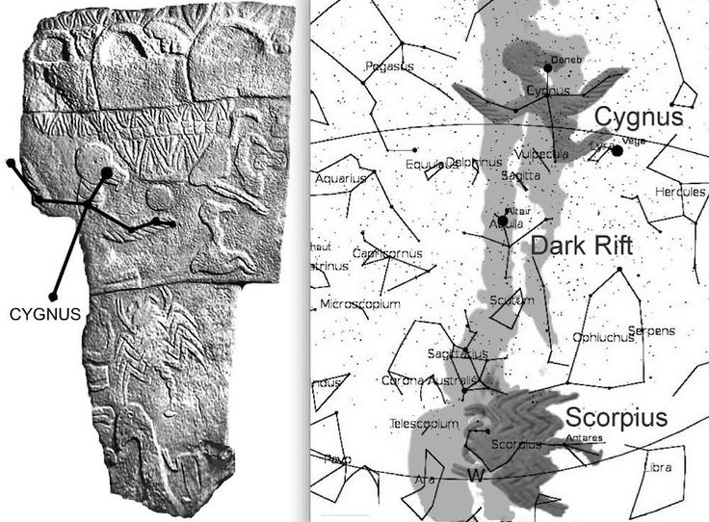
Figure
10. Left, Göbekli Tepe's Pillar 43 with Cygnus overlaid and, right, star
map showing Scorpius overlaid with Pillar 43's scorpion and Cygnus overlaid with
the stone vulture (pic credits: Rodney Hale).
Figure. 11 to follow
Journey
of the Soul
It is more likely that Pillar 43 depicts the death journey of the soul of the deceased, or indeed that of the shaman (see below). This would be the removal of a soul from its physical environment, represented by the headless figure with an erection at the base of the stone - via Scorpius, signified by the scorpion, to its final destination among the stars. This destination, arguably the entrance to the "upper world" or sky-world of Eurasian shamanic tradition, appears to have been located in the vicinity of Cygnus, represented on the pillar by the main vulture, where the soul of the individual is shown as the ball above its left wing.
The carved image of a ball-like head or filled circle is recognized in the prehistoric rock art of southeast Anatolia as being a symbol of the soul.(9) This was because the seat of the soul was always considered to reside in the head or skull. It was for this reason that, during the early Neolithic age, skulls were removed from bodies and used afterwards for oracular purposes, something thought to have occurred at Jericho (Tell es-Sultan) in Palestine. Here a number of perfectly preserved decorated skulls, dating to ca. 7500-6000 BC, have been found that were most likely used for psychic communication with their former owners (see fig. 12).

Figure
12. Decorated skull found at Jericho, Palestine, dating to ca. 7000 BC (Pic credit:
Wiki Commons Agreement).
I demonstrate all this elsewhere,(10) and recently similar ideas have been voiced by Müslüm Ercan, director of Sanliurfa Museum, who is head of excavations at Göbekli Tepe on behalf of the museum. In an article titled "Signs of world's first pictograph found in Göbeklitepe," published in Turkey's Hurriyet Daily News on July 15, 2015, he proposed that: "The scene on the obelisk unearthed in Göbeklitepe [Enclosure D's Pillar 43] could be construed as the first pictograph because it depicts an event thematically. It depicts a human head in the wing of a vulture and a headless human body under the stela.(11)
"There are various figures like cranes and scorpions around this figure. This is the portrayal of a moment; it could be the first example of [a] pictograph. They are not random figures."
Ercan goes on to link the vulture imagery on Göbekli Tepe's Pillar 43 with the act of disposing of the dead through the practice of excarnation, along with its allied association with the transmigration of the soul: "There were no graves 12,000 years ago. The dead bodies were left outdoors and raptors [that is, vultures] ate them. In this way, people believed the soul goes to the sky." This, he said, was called "burial in the sky," i.e. sky burial, and is depicted in the carved art at Göbekli Tepe, and also at the 9,000-year-old Neolithic city of Çatalhöyük in southern-central Anatolia. Here, shown in one particular painted fresco, are two vultures at the top of a wooden excarnation tower in the act of feasting on a human corpse, which as at Göbekli Tepe is shown as a headless figure (see fig. 13). Yet next to this scene are two more vultures on another excarnation tower that appear to be taking under their wings a ball-like head, this time with a mouth and two eyes. What we are almost certainly seeing here are the birds accepting into their care the soul of the deceased person in preparation for its journey to the next world. Other frescoes at Çatalhöyük show vultures with anthropomorphic features, suggesting they are shamans in the guise of vultures caught in the midst of ecstatic trance.

Figure
13. Frescoe from Çatalhöyük in southern-central Anatolia showing
vultures devouring a corpse on the right and taking a soul into their cave on
the left (pic credit: Andrew Collins).
Very likely the ball above the left wing of the vulture on Göbekli Tepe's Pillar 43 is the soul of either a deceased person, or that of a shaman, now under the protective care of the vulture who is acting in the capacity of psychopomp, a Greek word meaning "soul carrier," or "soul accompanier." Thus the visual evidence presented by the Vulture Stone allows for a comparative and consistent interpretation of its carved relief. With this in mind, it seems more plausible to conclude, as archaeologist Müslüm Ercan has done, that the overall theme being presented by the pillar's pictorial art is one of the soul's cosmic journey, which was likewise the journey taken by the spirit of the shaman to reach the world of spirits. This is expressed in terms of the vulture carrying the disembodied soul into an otherworldly environment accessed via the Cygnus star Deneb, the recently confirmed astronomical targets of Gobekli Tepe's Enclosures B, C, D & E.
Although this explanation is more certainly more plausible, infinitely more tempting, to the general reader at least, is the idea that the Vulture Stone is a warning of impending doom conveyed across time by the Göbekli builders. This is unfortunate, as despite all the evidence to the contrary, this is likely to become the most popular interpretation of the stone's carved imagery well into the future. Well, certainly until we have safely navigated the 80-year window during which the earth might once again come under threat from the remaining fragments of the Younger Dryas comet!
Notes and References
1.
Schoch, Robert. Forgotten Civilization: The Role of Solar Outbursts in Our
Past and Future, Inner Traditions, VT, 2012, pp. 54-5.
2. Magli, Giulio.
"Possible Astronomical References in the Project of the Megalithic
Enclosures
of Göbekli Tepe," Cornell University Library online, 2013,
http://arxiv.org/abs/1307.8397
(accessed September 15, 2015).
3. For criticisms of Schoch's theory on Orion
at Göbekli Tepe see Collins, Göbekli Tepe: Genesis of the Gods, Inner
Traditions, Rochester, VT, pp. 78-80. For criticisms of Magli's theory of Sirius
at Göbekli Tepe see Collins and Hale, "Göbekli Tepe and the Rising
of Sirius," 2013, https://www.academia.edu/5349935/GÖBEKLI_TEPE_AND_THE_RISING_OF_SIRIUS
(accessed September 15, 2015), and also Collins, 2014, p. 80.
4. Collins,
Andrew, "First Pictorial Representation of Göbekli Tepe Found,"
Ancient Origins, September 17, 2015, http://www.ancient-origins.net/news-history-archaeology/first-pictorial-representation-gobekli-tepe-found-003862.
5.
See, for example, Belmonte, J. A. "Finding Our Place in the Cosmos: The Role
of Astronomy in Ancient Cultures." Journal of Cosmology 9 (2010):
2052-62.
6. Burley, Paul, "Gobekli Tepe - Temples Communicating Ancient
Cosmic Geography," March 8, 2013, Graham Hancock website, http://grahamhancock.com/burleyp1/
7.
See, for instance, Richard Hinckley Allen, Star Names: Their Lore and Meaning,
G.E. Stechert, New York/Leipzig, 1899, for material on Cygnus, Lyra and Aquila
being identified as vultures. For the reference to the three celestial birds being
paranatellons of Sagittarius see p. 58.
8. Lorenzis, Alessandro de, and Vincenzo
Orofino, "New Possible Astronomic Alignments at the Megalithic Site of Göbekli
Tepe, Turkey," Archaeological Discovery 3, 2015, pp. 40-50. http://www.scirp.org/Journal/PaperInformation.aspx?PaperID=53506.
The authors acknowledge that Deneb as an astronomical target at Göbekli Tepe
was originally proposed by myself and Rodney Hale. See Collins, 2014, pp. 81-6.
Indeed, the alignments were tentatively proposed as early as 2006 in my book The
Cygnus Mystery, Watkins, London, 2006.
9. Uyanik, Muvaffak, Petroglyphs
of South-eastern Anatolia, Akademishe Druck-u. Verlagsanstalt, Graz, Austria,
1974, p. 12.
10. See Collins, Andrew, "Göbekli Tepe's Cosmic Blueprint
Revealed" at http://www.andrewcollins.com/page/articles/Gobekli.htm.
This is material taken from the author's Göbekli Tepe, Genesis of the Gods.
11.
"Signs of world's first pictograph found in Göbeklitepe," Hurriyet
Daily News, July 15, 2015, http://www.hurriyetdailynews.com/signs-of-worlds-first-pictograph-found-in-Göbeklitepe-.aspx?PageID=238&NID=85438&NewsCatID=375.
With
thanks to Rodney and Joan Hale, Catherine Hale, Debbie Cartwright and Graham Hancock.
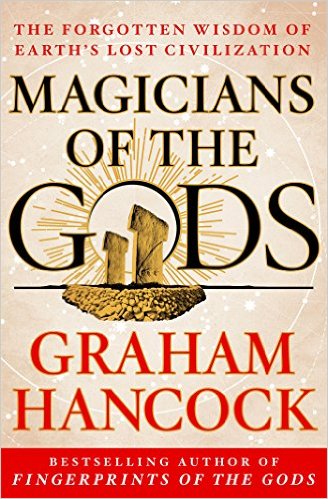
Graham
Hancock's book Magicians of the Gods: The Forgotten Wisdom of Earth's Lost
Civilization, published by Coronet, London, 2015, is available to buy from
Amazon
and other online bookstores.
Here
all these subjects debated at the Origins 2015 event in London on November 7th,
2015.
Click for more information and immediate registration
CLICK
TO RETURN TO NEWS PAGE